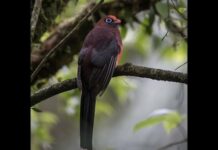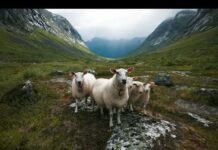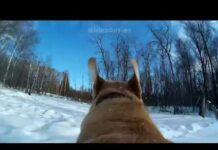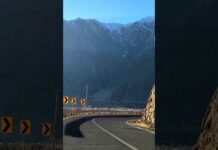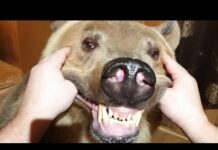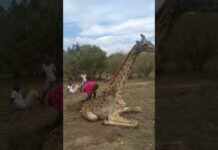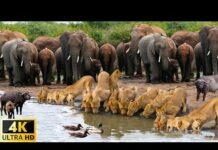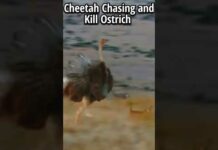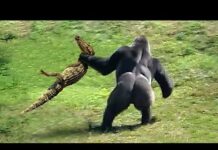Europe’s biggest industrial area turns green! For more than 150 years the Ruhr Area was not only the heart of Germany’s economy, but also Europe’s most extensive industrial zone. Mines, steelworks and chemical industries dominated the region. River systems collapsed and the skies were ash-grey. But over the last decades the area has been transformed. Due to the crisis in coal and steel, many industries were shut down, and huge areas were abandoned. A whole variety of animals returned to fill the vacuum; invading factory ruins, and re-colonizing badlands, artificial hills and lakes. Now peregrines breed on old smokestacks, natterjack toads occupy temporary pools and blue-winged grasshoppers display on hot and stony wastelands. This film not only tells the story of a unique comeback, it also reveals some stunning animal behavior. Above all it celebrates the power and adaptive capacity of life itself.
the river roar at first glance it seems idyllic but nowhere else in europe has man sacrificed nature for his own interests as profoundly as he has here for centuries.
Animals barely survived here however the decline of heavy industry marked the beginning of a brand new chapter in the life of the rural valley a place where plants and animals are now.
Reclaiming what seemed to be lost forever today the industry of the rua valley blazes with a different light instead of molten steel the former steel mill of duisburg miderisch is now illuminated by light installations.
There are no other signs of life but that doesn't mean there is no life the iron forest stirs why are desolate wastelands irresistible to some animals what are they looking for amongst the scrap metal and steel monsters the rural valley is the largest urban agglomeration in germany.
5 million people live in 15 cities metropolis borders metropolis for a long time it seemed there was no space for wildlife even today smokestacks still darken the sky but their numbers are falling miraculously the decommissioned chimneys now attract a bird that was almost.
Extinct in europe only a few decades ago the peregrine falcon for the peregrine the higher the better whether natural cliff or man-made building its chicks are only three weeks old and have already developed a hearty appetite safe and sound in their nesting box they.
Are free to eat in peace the rua valley is ideally suited for the comeback of this charismatic bird no other man-made landscape offers quite so many sky-high breeding sites peregrine falcons specialize in hunting medium-sized birds.
The wood pigeon is now a common bird in the region and the perfect size usually it nests in trees but it also uses the nooks and ledges of buildings the falcon needs space to catch its prey so the pigeon's best option is to stay close to the man-made structures the river flows 120 kilometers down the.
Valley and lends its name to the whole region despite once being europe's biggest industrial area a few green areas have survived the remains of the riverbank forest suggest how it might have looked 300 million years ago vast rainforests growing in a tropical.
Climate decaying trees then sank into the mud and were transformed over millions of years into what humans most desired coal coal has been mined here for centuries at its height in 1956 125 million tons were extracted in a.
Single year coal enabled the production of iron and steel industrial complexes emerged transforming the area beyond recognition the decline began in the 1970s when demand for the roars coal began to dwindle.
And the number of industrial ruins began to rise since then nature has been regaining ground largely unimpeded sometimes it's in the smallest cracks sometimes whole structures today undemanding birch trees forest pioneers grow in bunkers once used for storing iron ores and coking coal.
foxes are famous for their ability to adapt to new habitats the robin has spotted the vixen but no one else seems to take any notice within the ruins it can search for food in broad daylight without being targeted by human hunters countless cracks holes and fissures.
Provide ideal hideouts for mice and other small animals the fox's preferred prey provided there are enough hedges and woods nearby many a former forest dweller finds these abandoned steel mills with their various hiding places to be the perfect habitat.
But where factories were only demolished a few years ago everything lies abandoned it will take years for bigger plants to take root in this compressed soil and yet there is someone for whom this surface is just right the little ringed plover perfectly adapted to life on gravel.
Banks this family is looking for spiders and insects quick as a flash the birds move from place to place essential for survival in open spaces the young ones are on their feet from day one mimicking their parents in recent years the birds have become.
Increasingly rare as their usual habitat shrinks new breeding sites like this demolition area are a great help open spaces are vital to the little ringed plovers survival ensuring that no one can approach unseen caring for one's plumage is part of.
Growing up even though the young ones will soon fledge they still seek their mother's warmth and shelter a common kestrel has he spotted the family the vigilant father warns the others bravely the mother tries to draw.
Attention to herself she can fly away her young cannot elsewhere abandoned land has already become overgrown recapture by nature means constant change soon even more plants will populate these wastelands.
And there will be other new arrivals plant pioneers like the vipers bugloss have a hard time on the compressed and poisoned ground but where they succeed in settling they offer insects a taste of paradise once there are small animals bigger.
Animals soon follow where vegetation and abandoned equipment provide enough cover one popular garden dweller finds shelter the hedgehog has a hard time surviving in clean and tidy suburban plots with neatly trimmed lawns but here there are plenty of hideouts.
For this mother and its offspring a family of hedgehogs in broad daylight is an unfamiliar sight yet no one bothers them in these old industrial facilities while this male is off looking for food on his own his sibling still begs for milk as mothers nursed their young for six weeks.
it's very insistent it seems the mother thinks it's time to cut loose but it gets what it wants in the end there are plenty of treats to be found in the foliage an earthworm would be the perfect.
Dessert for the little one but the brother has no intention of sharing meanwhile the small family doesn't know they are being watched but their sensitive noses are not so easily fooled.
the vixen gives up there are many interesting hideouts in amongst the rusty mining gear some of them offering shelter this is exactly what they are missing in many of the clean and tidy gardens the best shelters come from a time when the rural region was exploited to its.
Fullest throughout the year hedgehogs use foliage to build comfortable nests an ideal place to sleep the sulfur ein colliery what used to be the largest coal mine in the world is now an industrial artifact.
By the end of the 60s output was still at 3 million tons per annum the mine was abandoned for good in 1986 after 135 years of service today many slag heaps are popular tourist attractions to animals they offer little bit hard soil rainwater accumulates in large puddles.
But it's nothing permanent and yet surprisingly one can hear a concert during the mild spring nights in the seemingly dead junkyard a couple of natterjack toads once he's found her the male holds tight to his mate meadow wetlands the original habitat of.
The natijac toad have largely been destroyed as a result they must relocate to artificial habitats in the throes of passion the male grabs her the wrong way it takes a while for them to find the right position again today the endangered toads could be.
Found in very high numbers on the wastelands between ryan and rohr but why and how firstly the tiny bodies of water exist so briefly that no predatory fish can settle secondly the water doesn't drain.
Immediately giving the tadpoles the three weeks they need to develop into fully grown toads the shortest period needed by any amphibian in a temperate zone but the toads eden is temporary eventually plants will invade the plateau rising from the slopes.
Of course these huge heaps have come from underground mining often leads to cave-ins and groundwater fills these sinks creating fence and lakes now they form a patchwork of different wetlands along with the remains of the rura's old water meadow.
A watery wilderness attracting many animals including the grey heron these stalk sized fishermen nest in large colonies in tall trees preferably close to water those who don't find an empty nest from the year before must start building all over again with both partners joining in the work.
once business is taken care of it's time for pleasure the heron population in the river valley increased significantly after heron hunting ceased the waterlogged forest reveals what the whole roar valley would look like if it weren't for more than 800 pumps that.
Constantly drain away the groundwater hallerai lake is one of the oldest examples of mining subsidence the calls of black-headed gulls bring it to life beneath them their nesting sites reveal.
An entire drowned forest compared to other colonies this one seems small but it is one of the most significant in densely populated germany the chicks are able to swim from day one though they rarely dare to leave the nest for the little one the nest is shelter.
Despite a rotting cadaver washing up the parents refused to abandon the site adult gulls sometimes feed on carrion but the chick is fed regurgitated fish instead it's hard to believe that this oasis is just an unintended byproduct of mining on the northern outskirts of the rural.
Valley traversed by roads and industry large forests dominate the landscape 200 years ago this was all heath land incredibly these woodlands also owe their existence to mining as the mine shafts had to be supported by wooden pillars the demand for so-called pit wood was enormous.
So pine trees were planted on a large scale today the woods are left to themselves providing enough space for red deer the largest of forest inhabitants the deer rut in autumn is an impressive spectacle of nature taking place just a dozen miles away from the center of the ruined.
Megalopolis roaring stacks impress both rivals and does with their far-ranging calls during the rut the stags move from the thick forest out into the open allowing us to see them in a way that is possible in only very few of europe's.
Industrial nations as only the strongest male is allowed to mate stags do challenge each other but real fights only break out rarely the dominant stank is constantly busy keeping his harem together who the females will mate with is still.
Unclear over many decades nature was seen as little importance in the rural valley and widely destroyed yet people searched for a way of compensating for their loss the gloomy working-class neighborhoods have become neat suburbs now.
But a 150 year old tradition is still cherished klaus schmelzer is one of about 10 000 breeders of carrier pigeons in the rural valley he used to work as a foreman in the coal mines and got his first pigeon loft when he was only 14 years old.
His hobby helped him deal with the hard work demanded by his job as the number of miners falls so does the number of pigeons race days are the highlight of the year for pigeon fanciers but to be successful the birds have to train regularly.
under the watchful eye of their owner for about two decades now the airways have been getting more dangerous new arrivals are moving into the neighborhood.
Occasionally the odd pigeon fails to return peregrine falcons don't distinguish between wild pigeons and those beloved by breeders little surprise then that wildlife conservation is not welcomed by everyone pigeon fanciers in particular may struggle to admire these returning.
Aerial hunters in many places today's rural valley appears quite green the vestiges of industrialization like this old foundry are now just monuments to decay leftovers from a noisy and hectic age.
But these images also bear witness to an era of economic prosperity with full employment in the rule today this hall provides space for industrial nature and a hiding place for a secretive hunter martins are amongst the first to take possession of abandoned buildings.
As former rock dwellers they have adapted well to living in man-made structures like the fox martins find plenty of prey in the numerous crevices the roof shelters them from the rain for now the hall provides their offspring with the ideal environment for exploration.
Protected from airborne predators though it's not always easy even mother can't help she has other things on her mind there's an abundance of little rodents in these ruins making them ideal spots for a mouse catcher.
Despite the predators the hall is a good place for mice too where else would they find so many hiding places fortunately for the mouse martin is soon distracted inside the walls live weird creatures that seem to consist entirely of legs giant harvest men.
Their legs span 20 centimeters migrants from africa they first turned up in germany in 2004 they are partial to abandoned buildings dry and free of frost often hundreds of them gather in one spot when threatened they shake their bodies to warn neighbours and confuse predators.
For these arachnids the many industrial ruins of the ruer valley provide excellent new habitats but these bizarre creatures aren't the only animal migrants here juicebook the world's largest inland harbour.
Animals that usually live much further south have settled down here common wall lizards now sunbathe along the riverbanks using the nooks and crannies as hideouts somehow chewsball harbour now boasts one of the most northern populations of the species.
As cold-blooded animals these reptiles need to get their energy by the sun fortunately the rhine valley has a warmer climate than other places on this latitude how they got into the harbour is unknown they may have been released or come by water from the south a different immigrant surely came by.
Ship the chinese mitten crab introduced to the north sea at the beginning of the last century it has now conquered the rua and the rhine amongst other places only able to spawn in salt water the adults migrate to the sea and cover an astounding 10 kilometers per day for.
Months on end after spawning the adult crabs die and the young returned to the rivers of the rural valley along the way they must repeatedly return to the water to find their food fresh water plants small fish and even mussels the crabs break open the shell with.
Their strong claws but they also annoy the fishermen by cutting their nets and no one has been able to stop them from spreading recently the crabs have been exported back to china where they are a rare delicacy not all wildlife can cope with the.
Hustle and bustle of urban spaces the water meadows of the roar are often called the green lungs of the industrial region a retreat for many more sensitive species however it isn't as pristine as it first appears.
this is not a european beaver they disappeared before industrialization and have yet to return neither the exotic slider turtle nor the nutria are native to the region nevertheless in the protected areas of the rue's floodplains they find shelter alongside many original inhabitants.
this newly hatched dragonfly will soon be master of its territory and even a rare grass snake has made the area its home large animals have been reintroduced by conservationists.
Since the beginning of the 21st century part of the rural water meadows have been grazed by a herd of semi-feral heck cattle reminders of a time when cattle herding was common in the rural valley they helped to conserve the open spaces of the rura's floodplains.
The rural valley features a fascinating mix of ancient and new natural landscapes more than 150 artificial table mountains now rise above what was once flat country reaching heights of up to 100 meters some slag heaps are still used and grow into bald mountains.
Others are slowly being reclaimed by the forest incredibly the bare poisoned wastelands still represent paradise to a number of specialists the blue-winged grasshopper is one of them.
Perfectly camouflaged on the rocks it avoids any unnecessary movement just like its close relative the slender blue winged grasshopper when threatened these wasteland pioneers reveal their true splendor they are perfectly adapted to life on the ground.
And feed on low growing plants they also shun chirping in favor of visual communication leg movements convey information without making a sound sometimes though they simply need to find each other in this rough terrain so when a male discovers a female it signals with its blue wings.
A match made in slag heap heaven only when they are sure they belong to the same species of blue wing do they finally mate natural barren landscapes have almost vanished in central europe and the grasshoppers depending on them are highly endangered.
Yet even for them it is only a temporary refuge in the end nature won't be stopped one day everything will be cloaked in green once more this script is playing its part as a master gardener it ensures the spread of tree fruits.
Such as acorns and nuts by collecting them and burying them for the winter but the eager collector doesn't dig all of them back up the mist fruits sprout into new shoots which will in turn grow into a forest over the next 30 to 40 years it takes time for nature to heal itself and in many places heavy industries are.
Still in operation some well-traveled visitors have made a virtue of necessity the towers of the power plant do not bother the resting greater white fronted geese on the contrary.
Thermal discharge causes the highly coveted winter seed to remain mostly free of snow and it's not far to the lower rhine where the geese can rest on its great marshy plains the airways between the rhine and rural are bustling.
Great industrial complexes are still growing and stacks are still smoking in many places of the rural valley but the emptier is an example of how a region can be improved by human intervention the river had served as a sewer for decades and was europe's biggest cesspool.
for the past 25 years a massive effort has been made to direct the waste water 70 percent of the river's volume underground over 400 kilometers of piping is now due to carry the waste water channel it underground and return it into the ymca.
After it has been purified in a treatment plant the goal to restore the entire course of the yamcha river where it's already free of her concrete corset it meanders through the landscape clear and clean the new habitat appears to be.
Tailor-made for the banded demoiselle these heat-loving insects need small streams that are not too densely vegetated and still receive ample sunshine the green colored females are well camouflaged the flashier males try to impress them.
With courtship dances that show off their full splendor they use their colored wings as signals and to drive off other males from their territory which barely stretches a few square meters.
If a female lands in it then the male will lead her to where she will lay her eggs the couple then formed the usual mating wheel shortly afterwards the female lays her eggs and the larvae hatch about nine weeks.
Later maybe in a few years this animal will also resurface in the emptier the eurasian otter it has already returned to a few spots on the lipper the river on the northern border of the rura area.
This big martin needs clean waters in which to hunt for fish although it always comes ashore to eat for 50 years the eurasian otter was extinct throughout north rhine westphalia as it was unable to find clean water.
Should it permanently return to the yamcha and rua then this would be a great success for nature conservation and atonement for past sins for decades the air in the rural valley was polluted and the land exploited and abused inevitably nature had to pay for such.
Ruthless exploitation however with its incredible power of regeneration it manages to thrive even on ruins the peregrine falcon is clearly one of the beneficiaries of the structural changes that have occurred even if it was with the help of man.
The rural region is now home to more of these elegant raptors than anywhere else in germany smokestacks act as surrogate rocks this year's brood was nurtured well by the breeding pair one of 100 in the region the young birds are now fully fledged but they're made in flight is a leap.
Into the unknown they have no choice but to trust their wings to encourage them the parents refuse to feed the youngsters until they take to the skies and so they do.
no animal is a natural-born master of flight not even the fastest flyer on the planet the young falcons are unaware that it used to smell smolder and rumble here they don't need untouched wilderness the only things that matter to them are whether they can hunt and whether they.
Can find high enough places to nest today many of the steel giants appear to be nothing but legacies from another era but the rue valley is staged to an incredible transformation from a heavily polluted coal mining area to a home for specialists and adaptation.
Experts for those who know how to exploit it the iron jungle has plenty to offer you
We are excited to present to you the captivating video titled “Iron Jungle – Nature’s Return to the Ruhr Valley – Go Wild”. Get ready to embark on a journey of enjoyment, smiles, and laughter as you watch this delightful creation. “Iron Jungle – Nature’s Return to the Ruhr Valley – Go Wild” is a perfect blend of entertainment and amusement, carefully crafted to bring joy to your day. From the moment you press play, you’ll be greeted with a cascade of lighthearted moments, heartwarming scenes, and perhaps even a few surprises that will tickle your funny bone.
Whether you’re in need of a quick pick-me-up or simply looking for some light-hearted entertainment, “Iron Jungle – Nature’s Return to the Ruhr Valley – Go Wild” has you covered. The video promises to deliver a collection of moments that are bound to leave you grinning from ear to ear. With its engaging content and skillful presentation, “Iron Jungle – Nature’s Return to the Ruhr Valley – Go Wild” is more than just a video – it’s an experience designed to brighten your mood and spread positivity.
The creators of “Iron Jungle – Nature’s Return to the Ruhr Valley – Go Wild” have poured their creativity and dedication into crafting a visual treat that resonates with audiences of all ages. Through expert storytelling, impeccable timing, and an array of engaging content, “Iron Jungle – Nature’s Return to the Ruhr Valley – Go Wild” promises to be an unforgettable journey that lingers in your memory long after the video concludes.
So sit back, relax, and prepare to be entertained as you dive into the world of “Iron Jungle – Nature’s Return to the Ruhr Valley – Go Wild”. It’s a delightful video that aims to bring a dose of happiness to your day, leaving you with a lasting smile and a heart full of laughter.
This video was uploaded in youtube and has recieved 46773 views so far. This is a great achievement and laso it has received 692 likes and .
Data bout the video:
Rating: ,
Video dimensions: 2d,
Video definition: hd,
Video duration: 00:49:08,
Video favourite count: 0
Video comment count: 34


